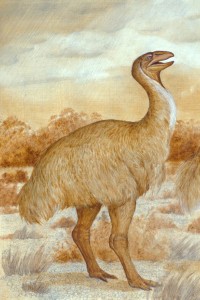Monster Monday: The Demon Duck of Doom
Monday, May 30th, 2016May 30, 2016
How many breadcrumbs would it take to feed a 1,000-pound (450-kilogram) duck? Measuring over 10 feet (3 meters) tall, the extinct thunder bird is sometimes called the demon duck of doom. This gigantic, flightless bird lived in what is now Australia, dying out 30,000 to 50,000 years ago.
Despite its demonic nickname, the thunder bird probably did not feast on flesh, but was mainly herbivorous (plant-eating). It used its heavy, strong bill to gobble down fruits, seeds, and other plant matter.
Another name for the thunder bird is mihirung, which comes from the Australian aboriginal term mihirung paringmal, meaning giant emu. The bird’s long neck, tiny wings, and massive, powerful legs led people to think that it was a relative of emus and ostriches. However, scientists now believe that it was more closely related to ducks and geese. The thunder bird did not live in the watery habitats favored by modern ducks and geese, however. Instead, it preferred to roam in grasslands and nest in sand dunes.
All but one species of this monstrous bird had died out by the time human beings reached Australia about 50,000 years ago. Some scientists argue that people may have accelerated the extinction of the thunder birds by hunting them or setting fire to their habitats. Climate change also likely played a role.



